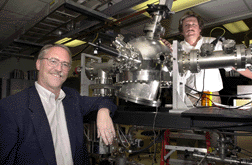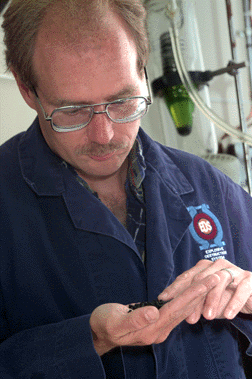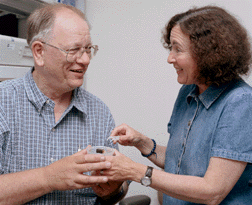FOR IMMEDIATE RELEASE
August 2, 2001
Sandia researchers win three R&D 100 Awards
|

SANDIA RESEARCHERS Barney Doyle, left, and George Vizkelethy stand next to the Ion Electron Emission Microscope they developed. The technology won them an R&D 100 Award. (Photo by Randy Montoya)
Download 300dpi JPEG image, ‘Doyle_Vizkelethy.jpg’, 940K (Media are welcome to download/publish this image with related news stories.)
|
ALBUQUERQUE, N.M. — Three research teams from the Department of Energy’s Sandia National Laboratories have won R&D 100 Awards in the annual competition for innovative technology sponsored byR&D Magazine,a trade magazine based in the Chicago area.
Technical experts chosen by the magazine select 100 winners of the annual contest. The winners must not only be original but also show promise of real-world application.
Winners will be honored at a banquet hosted by the magazine in October at Chicago’s Museum of Science and Industry.
The Sandia winners invented an Ion Electron Emission Microscope, polymer hydrogen getters and a new process for growing compound semiconductors of cadmium-zinc-telluride for room temperature radiation detection.
“Sandia’s R&D 100 winners represent fundamental advances in technology that are so essential for making progress in other fields,” says Sandia President C. Paul Robinson. “All three awards represent new inventions, and all make significant strides in extending the state of the art and are extremely cost-effective over past methods.
“Developing such ‘systems solutions’ is what we emphasize as Sandia’s reason for being, and it is very rewarding to see the R&D 100 Awards honor the work,” Robinson continues. “I am also pleased that two of the three awards included team members from industry and universities. Technology partnerships are also a major Sandia thrust, and these awards indicate that.”
Also praising Sandia’s award-winning technology was National Nuclear Security Administration (NNSA) chief Gen. John Gordon. He said, “The R&D 100 awards received by Sandia and other NNSA labs are recognition of the world class science conducted at these labs. While our primary mission is national security, it is gratifying to know that this work is also having an impact on the improvement of technologies used to create such things as consumer products, environmental cleanup tools and medical diagnosis equipment.”
The winning technologies are:
Ion Electron Emission Microscope
The Ion Electron Emission Microscope (IEEM), invented by Sandia researchers Barney Doyle and George Vizkelethy, Robert Weller of Vanderbilt University and Berthold Senftinger of Staib Instruments, Inc. in Germany, is the first device that allows scientists and engineers to microscopically study the effects of single ions on semiconductors, integrated circuits, and biological specimens without having to focus the MeV ion beam. The IEEM nomination was submitted jointly by Sandia and Staib, the company manufacturing the microscope.
Doyle says that unlike earlier microscopy systems, one version of the IEEM — the alpha-source IEEM — doesn’t even use an accelerator.
“It replaces a building full of expensive accelerator and nuclear microfocusing equipment with a device the size of a scanning electron microscope,” Doyle says. “It will also be a fraction of the cost of a conventional nuclear microprobe.”
The low cost and size come at no reduction in capability and even enable for the first time some experiments using accelerators, which were previously considered unsuitable for nuclear microscopy.
Doyle speculates that this development “could well lead to a renaissance in nuclear microscopy, particularly for studying electron transport in semiconductors and microelectronics and for radiobiology research.”
The IEEM does not focus high-energy ions like the Hybrid Nuclear Microscopy System, which has been the standard for locating problem areas in radiation-hardened integrated circuits for the past decade. Instead it determines the position where an individual ion enters the surface of the sample by projection secondary electron emission. These position signals are then correlated with the ion-induced signal generated in the sample or device under test.

SANDIA RESEARCHER Tim Shepodd, co-inventor of the polymer hydrogen getters, calls the product the “greatest advance in getters in 50 years.” The technology has won an R&D 100 Award. (Photo by Lynda Hadley)
Download 300dpi JPEG image, ‘Tim_Shepodd.jpg’, 1MB (Media are welcome to download/publish this image with related news stories.)
|
|
Polymer hydrogen getters
Tim Shepodd, co-inventor of the polymer hydrogen getters, calls the product the “greatest advance in getters in 50 years.” The getters permanently and irreversibly remove unwanted hydrogen and, as a result, can prevent explosions caused by hydrogen mixing with the atmosphere in sealed consumer products and avert hydrogen buildup that can result in a decrease of insulation properties or loss of efficiency in evacuated heat exchangers.
Sandia’s Shepodd and co-inventor LeRoy Whinnery are receiving the R&D 100 award for the polymer hydrogen getters.
“Our getters allow the safe use of sealed, battery-operated devices such as flashlights, dive-lights, toys, and cameras without the risk of inadvertent detonation,” Shepodd says.
The polymer hydrogen getters function in two ways. They either scavenge hydrogen with carbon-carbon multiple bonds, or, when oxygen is present, safely make water through recombination. The Sandia getters are customized for each application, made from readily available ingredients, nonhazardous, and remove hydrogen in a variety of atmospheres, including vacuum, inert, air, or steam.
“Polymer hydrogen getters are a spectacular example of an enabling technology,” Shepodd says. “They are deployed as a small, passive part of numerous technologies and are usually less than one percent of the mass and cost. Yet without getters, some technologies may not be able to be safely or economically deployed. A flashlight that explodes, a camera that could malfunction or explode — these consumer products are made safe by our technology.”
Sandia’s polymer hydrogen getters are currently marketed under a licensing agreement with Vacuum Energy Inc. of Cleveland, Ohio.
|

RICHARD OLSEN and Eilene Cross hold the Sandia R&D 100 Award winner, solid state radiation detectors. (Photo by Linda Hadley)
Download 300dpi JPEG image, ‘Olsen_Cross.jpg’, 864K (Media are welcome to download/publish this image with related news stories.)
|
Solid-State Radiation Detectors
Detecting and imaging nuclear materials, such as radiotracers in nuclear medicine, just got easier. The reason is a new technique of growing large single crystals of cadmium zinc telluride (CZT) suitable for radiation detectors. The technique was developed by a Sandia research team; Yinnel-Tech Inc. in South Bend, Ind.; Techion — Israel Institute of Technology; and Fisk University.
“Progress in the area of solid-state X-ray and gamma-ray detectors has been linked to producing better crystals. Our discovery of a technique to grow large single crystals of CZT with the desired electrical properties has begun to transform the technology area, creating new thrusts and directions for solid-state radiation sensors and imaging arrays,” says Ralph James, who served as the Sandia principal investigator for the project. He left Sandia this spring to join Brookhaven National Laboratory as associate laboratory director.
The new solid state radiation detectors are unique because they can operate at room temperature, detect X- and gamma-ray radiation with high efficiency, and uniquely identify the isotopes responsible for the emitted radiation.
The team’s development of an improved technique to grow detector-grade CZT crystals and a new method to reduce the dark current flowing along the crystal surfaces have allowed for major improvements in the signal-to-noise ratio, long-term stability, and yield of single-crystal material.
James says the detectors have diverse applications, including environmental cleanup, imaging of gamma-ray bursts, radiography, safeguarding the world’s inventory of nuclear materials and improved detection of tumors and heart disease.
Sandia is a multiprogram laboratory operated by Sandia Corporation, a Lockheed Martin Company, for the United States Department of Energy under contract DE-AC04-94AL85000. With main facilities in Albuquerque, N.M., and Livermore, Calif., Sandia has major research and development responsibilities in national security, energy and environmental technologies, and economic competitiveness.
Sandia media contact:
Chris Burroughs, coburro@sandia.gov, (505) 844-0948
|
